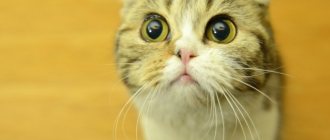Alena Igorevna Goncharenko
veterinarian Petstory
Mastitis in cats is a disease in which inflammation of the mammary gland occurs. This disease is mainly typical for young cats that have recently given birth. This condition requires immediate medical attention due to the fact that both the cat itself and its kittens can suffer.
Mastitis in a nursing cat: the main thing
- Most often, mastitis can be found in young lactating cats, less often in older cats and cats.
- Mastitis can occur either unnoticed by the owner or the cat itself, or with pronounced clinical symptoms.
- The diagnosis of “mastitis” can be made based on a general examination of the animal, but research will be required to clarify the nature of the inflammatory process.
- With a correct and timely diagnosis, treatment is not difficult.
Types of mastitis
Lactational
Lactation mastitis develops soon after birth, while feeding kittens. At this time, the mammary gland is in the phase of its most active functioning. A large number of cavities appear in the mammary gland, which are filled with milk. These cavities are surrounded by fatty tissue. The vascular network is actively growing. All this is a favorable environment for the development of pathogenic microflora. Lactostasis, that is, milk stagnation, also contributes to the development of mastitis. For some reason (few kittens, a lot of milk) milk is not evacuated from the mammary gland quickly enough and stagnates. In such milk the risk of developing foreign infection also increases. Bacterial waste products can lead to fermentation of milk and the formation of clots. These clots can block the milk passages and lead to even greater congestion.
Non-lactational
This form of mastitis occurs in non-pregnant cats. The cause may be injuries in the mammary gland, the development of deep infection of the skin, fatty tissue and other nearby tissues, or the use of hormonal drugs.
Photo of mastitis in a cat
Spicy
It manifests itself with clear clinical symptoms: changes in skin color on the mammary gland, pain, swelling, and increased local temperature. The cat may be depressed or not show symptoms of illness. The milk may be red-brown, yellow-green, or remain white.
Chronic
Often the only symptom of chronic mastitis may be the kittens' reluctance to suckle from their mother. The cat may not show any signs of anxiety.
Catarrhal
If you palpate the mammary glands, you can find small lumps. After feeding the kittens or expressing milk, these balls disappear on their own. This course does not cause pain, high body temperature or other changes in cats. The main reason lies in stagnation of milk. This condition can also be called mastopathy.
Serous
The mammary gland becomes enlarged, swollen, and dense. During palpation, the cat may express painful sensations, and an increase in local temperature may be noted. If you try to express milk, a clear liquid will come out first, followed by milk. Milk may contain flaky inclusions.
Fibrinous
The gland is even more enlarged in volume, very dense. When palpated, the cat expresses serious dissatisfaction; sounds resembling crunching can be heard. With this sound, fibrin films that surrounded the mammary gland ducts and glandular tissue are destroyed. An increase in the size of the lymph nodes and an increase in overall body temperature can be noted. Along with the milk, flakes and films are released.
Hemorrhagic
This form of mastitis is characterized by hemorrhages in the breast tissue and adjacent tissue. The mammary gland is enlarged and painful. The milk turns pink or red and may contain blood clots.
Purulent
The cat's mammary gland is extremely painful and very dense. The skin may take on a pink or red tint. During palpation, the cat shows strong dissatisfaction. Purulent discharge from the nipples with a characteristic odor can be noted. Lymph nodes may be enlarged. The cat's general health may be unsatisfactory, she may be lethargic and refuse to eat.
Abscessing
Occurs in the absence of treatment for purulent mastitis. Cavities form inside the mammary gland and are filled with pus. Breast tissue begins to melt due to bacterial activity.
Gangrenous
This type of mastitis develops if anaerobic bacteria join the pathogenic microflora. They very quickly destroy mammary gland tissue and cause necrosis. You may notice a foul odor and a change in skin color to brown or black. Inflammation and infection spread to the tissue surrounding the mammary gland. If left untreated, this form of mastitis will cause serious complications to the cat and may die from sepsis.
Disease prevention
Timely implementation of preventive measures will help prevent the development of the disease and protect your pet from unpleasant symptoms.
Prevention methods for mastitis:
- Timely vaccination.
- Treatment of animal fur with antiparasitic agents. Since fleas cause severe itching, the cat can injure the mammary glands in the process of scratching, which contributes to the development of bacteria and infections.
- Selecting the right diet for a nursing cat, which does not contain products that affect the increase in milk supply.
- Providing the cat with satisfactory living conditions, a clean potty and bedding.
- Minimizing the risk of hypothermia or injury to the cat.
- Treatment of wounds and cracks on the nipples with a solution of potassium permanganate.
- Regular cat examinations.
- Expressing if kittens do not drink all the milk.
If you take care of your pet’s hygiene, diet, and regularly conduct examinations at the veterinarian, its mammary glands will not become inflamed. It should be remembered that preventing the development of mastitis is much easier than treating it. This will protect both the cat and kittens and their owners from unpleasant consequences.
Diagnosis of mastitis
Making the correct diagnosis (mastitis) begins with collecting a detailed medical history. If this is a cat that has recently given birth, you need to find out how the kittens are feeling, whether they are willing to eat, and whether they are showing signs of anxiety. It is also necessary to assess the condition of the cat itself, measure its temperature, palpate the mammary glands, evaluate the local temperature, swelling, density, skin color, pain, and the nature of the secretion.
Hurry up, choose a box and find out what gift awaits you
Discount on pet insurance
Promo code copied to clipboard
Laboratory diagnostic methods include blood tests. In clinical analysis, an increase in leukocytes and lymphopenia can be detected. With a pronounced process, a shift in the leukocyte formula to the left can be detected. In the biochemical analysis, there are no characteristic changes for mastitis; in some cases, an increase in transaminases may be detected; in an extremely severe condition, kidney indicators may be increased due to infection in them.
To assess the nature of the secretion secreted from the mammary glands, a cytological examination is performed. It can be used to detect the presence of blood cells, inflammatory cells, and bacteria in milk. Milk culture is also necessary to identify the type of pathogenic microorganism and titrate to antibiotics. In healthy animals, some bacteria are also found in the milk, but their abundant growth will indicate infection.
Causes of seals
The main reasons that lead to the appearance of swelling can be identified:
- Negative effects on the animal’s body from excessive environmental pollution;
- Unbalanced diet, presence of low-quality food in the diet;
- Hereditary predisposition to the development of pathologies;
Often the reason why a cat has swollen mammary glands after kittens lies in the early separation of the offspring from the mother. Most often, this condition does not have a negative effect on the pet’s body and goes away on its own over time. In this case, it is recommended to express milk both independently and with the help of a veterinarian. You can also make lotions at room temperature from a decoction of oak bark or chamomile.
Complications
The main complications of mastitis include the development of an abscess or gangrenous form. With such forms of flow, the risk of damage to other tissues around the mammary gland (skin, muscles) increases. Milk becomes completely unsuitable for feeding kittens; they must be switched to a formula - a cat's milk substitute and fed by hand. Treatment of such forms of mastitis may involve surgery to wash out the pus and install a drainage system, removing necrotic tissue. If the entire breast is affected, complete excision of the breast tissue may be recommended. If left untreated, the cat may die due to sepsis.
How to express milk?
To effectively treat mastitis, it is necessary to prevent stagnation of milk. Along with milk, foreign bacteria are also eliminated. If it has been recommended to remove the kittens from the cat or if they cannot cope with the volume of milk, it is necessary to express it.
- Wash your hands thoroughly.
- If the cat is very active, you will need the help of another person to restrain it. The cat can be placed on your lap with its back to you, or fixed on a flat surface on its side. You can use blankets or towels to cover your cat to prevent injury from claws and teeth.
- Carry out a gentle massage of the mammary glands. It is necessary to do this without obvious effort, but try to knead the dense slices.
- Grasp the mammary gland with your index finger and thumb and gently squeeze until drops of milk appear.
- If it is difficult to let milk out this way, you should not use physical force. It is worth contacting your doctor and clarifying whether you are doing everything correctly.
You can also use a breast pump for women to express milk during mastitis, but its power may be too powerful for cats. Then you should make a breast pump yourself. To do this you will need a 20ml syringe. It is necessary to cut off its upper part (the one where the needle is attached) with a knife. Burn the cut edges over a fire so that they do not scratch the cat's skin. Next, you need to lean the cut part against the cat’s mammary gland and pull the piston so that a vacuum is formed. If you did everything correctly, milk will begin to be sucked into the syringe.
Therapy - first aid and treatment.
In the initial stages, self-help for a cat with mastitis is acceptable, but in the future, at least a small intervention from a specialist is highly desirable. So, if the nipples are just a little swollen and red, but milk is coming out and the temperature is normal, try emptying your cat's mammary gland of stagnant milk.
Note! To do this, you can either bring the kitten to the sore nipple, or express milk using gentle pressure on the sore organ. Too strong, sharp touch can play a negative role. If you are worried that you won’t do everything carefully, invite someone who has experience. Not only a veterinarian can help here, but also an acquaintance, friend or neighbor - those who have encountered a similar problem with their cat.
Keep in mind that... ... Warm compresses sometimes help, but they can also cause harm. The fact is that heat is a good environment for the growth of bacteria. Therefore, lotions made from gauze soaked in a decoction of chamomile, sage or oak bark with a temperature of about 38 degrees can help much better. Sometimes a little cooling works even better. All you have to do is apply the cabbage leaf for 5 minutes, then turn it over and apply it for approximately the same time.
If you find out that you are producing too much milk, proceed as follows:
- Reduce the amount of liquid in your diet. For a day (but no more) you can even completely eliminate water. Replace soups and canned food with dry food.
- Wrap the nipples with a clean, soft cloth—tight enough, but not so tight that the cat’s movements are difficult.
When mastitis becomes purulent, kittens are fed artificially. Otherwise they will die. There is no need to separate the offspring from the mother, just rewind the cat's nipples and put a blanket on top. And only a qualified veterinarian can treat this stage of the problem.
If the problem affects only a few nipples (or one), then apply these tips specifically to them. Healthy kittens can feed without any threat to their well-being.
What about pain? You can use novocaine blockade, antibiotics (to kill the infection), open abscesses and treat inflammation with special means. If the situation occurs with a cat that has never given birth, veterinarian intervention is necessary. Well, milk stagnation is quite easily eliminated using modern methods that have proven themselves in veterinary medicine.
How to feed kittens with mastitis?
If the form of mastitis allows the cat to continue feeding the kittens on her own, then no changes in their diet need to be made. If your doctor has recommended that you temporarily or completely stop feeding your kittens milk, you should continue to feed them by hand. For this purpose, special mixtures are used - analogues of cat milk. The use of infant formula or other types of milk is possible only as a last resort; it has been proven that such kittens grow much worse and have more various diseases. This is due to the fact that the composition of milk of different animal species varies very significantly.
Stages of tumor development
The development of any tumor can be divided into several successive stages:
- The neoplasm is very small, no more than 10 mm, no metastases have been identified;
- The tumor grows up to 30 mm, all the same, without the appearance of secondary lesions;
- A growth over 50 mm in size, the appearance of ulcers and the possibility of developing metastases in the lymph nodes are noted;
- Identification of secondary lesions in the liver and other organs of the animal;
By starting treatment in the first stages, you can prevent complications and completely normalize the animal’s condition.
Treatment of mastitis in cats
The main drugs used to treat mastitis in cats are antibiotics. If the cat continues to feed kittens, it is necessary to use those antibiotics that can be given to small kittens. Usually these are antibiotics from the beta-lactam group. If other types of antibiotics are required, the kittens will need to be weaned and formula fed. The use of anti-inflammatory drugs also carries a risk of side effects in kittens. In some cases, the use of local anti-inflammatory drugs in the form of compresses or ointments may be indicated. Drugs that stop lactation can also be used.
In severe cases of mastitis, surgical intervention is used; dead tissue must be removed; in extreme situations, the mammary glands are removed entirely. For cats in serious condition, a venous catheter is installed, infusion therapy is performed, and inpatient observation is recommended.
What to do if you notice signs of mastitis?
You cannot do without consulting a doctor and examining the animal at a veterinary clinic. But while you are signing up, you can alleviate the cat’s condition a little:
- Provide peace to the cat, give it the opportunity to hide in a secluded place;
- If it is possible to wear a special blanket so that the cat licks the inflamed glands less;
- If there is a need to transfer kittens to artificial feeding.
Under no circumstances should you heat inflamed milk cartons. This can lead to the rapid spread of the microbial process and can greatly worsen the cat's condition. It is forbidden to apply newborn kittens to sore nipples, as infected milk can cause serious harm to the babies.
Depending on the type of mastitis and the severity of the process, the doctor individually selects treatment. The risk for kittens is also assessed, and often they are completely transferred to artificial feeding.
- Carrying out breast massages and expressing milk;
- Reducing the amount of fluid consumed;
- Applying external agents to the mammary gland (for example, camphor oil);
- Wearing a protective blanket to limit access to kittens and prevent the cat from licking milk bags;
For purulent and advanced processes, non-steroidal anti-inflammatory drugs (NSAIDs) and broad-spectrum antibiotics are prescribed. Most often these are amoxicillins with clavulanic acid and cephalosporins of 1–3 generations. Sometimes surgery is indicated.
To improve your cat’s condition and speed up the healing process, it is recommended:
- Place the cat in a warm, cozy place; it is important to ensure peace and absence of stress;
- Ensure the cleanliness of the room, beds, and blankets used by the cat (the blankets are washed regularly and then ironed).











